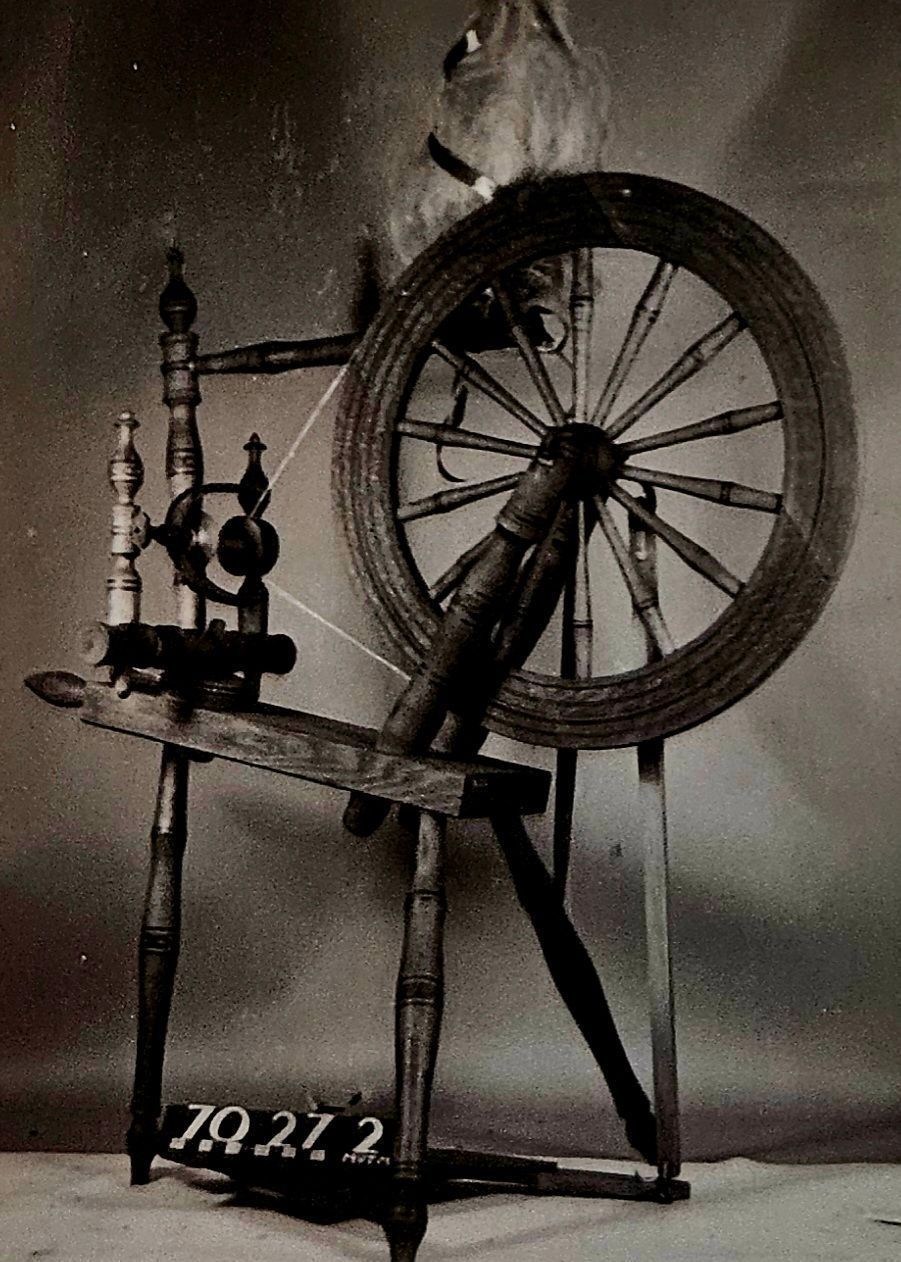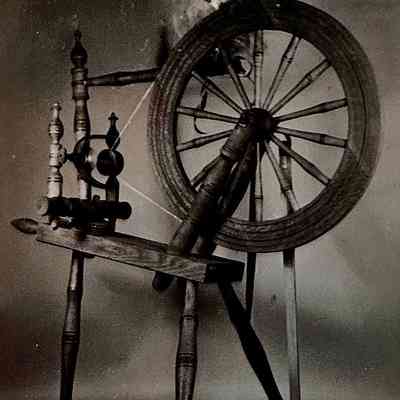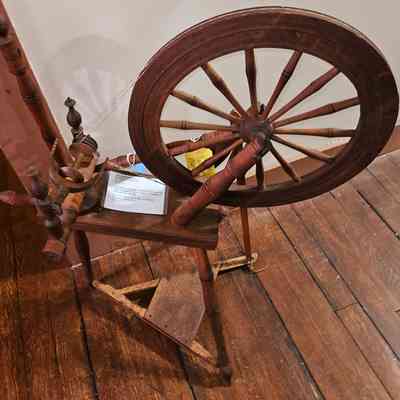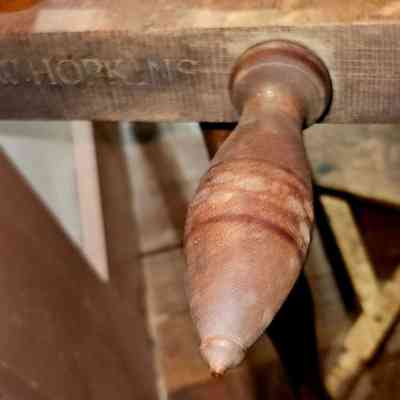Name/Title
Spinning Wheel, FlaxEntry/Object ID
2017.01.06Description
Flax spinning wheel. Striped wheel. Wheel bearings are made of horn or bone. Made by William Hopkins of Litchfield, CT, c. 1825. Establishing that there did exist a wheel-maker named William Hopkins in Litchfield in 1825, Elizabeth Cynthia Barney Buell, in "The Tale of the Spinning Wheel" (Cambridge, MA: University Press, John Wilson & Son / Litchfield, CT, 1903), pp. 27-29, [https://www.gutenberg.org/files/58950/58950-h/58950-h.htm] writes: "Here is a wool-wheel [owned by the Litchfield Historical Society] (see illustration), not so old as many others, perhaps, but all the more interesting for that, inasmuch as it proves how recently the real old homespun held its place amongst us. This wheel is a little out of the common. It was made by one William Hopkins, a resident of Litchfield, for his daughter, Nicey Melinda, about 1825. William Hopkins was a direct descendant of Joseph Harris, one of Litchfield's pioneers, who fell a victim to the tomahawk on Harris Plains in 1723. He had married Mary Hopkins of West Hartford, and lived just below the Symington Cottage. His daughter Abigail married a cousin Asa Hopikins, and their son Harris married Margaret Peck, sister of Paul Peck, 'the mighty hunter,' and became the father of William Hopkins of the spinning-wheel. William was a clever mechanic, and made this wheel to suit Nicey's particular fancy. It has two heads instead of one, -- a new and an old fashioned one, -- and the edge of the wheel is narrow and has a little groove in it instead of being broad and flat. Nicey Melinda married John A. Woodruff, and lived on a farm this side of the Town-house first; then they sold out there and came into Litchfield, where they took up a residence on West Street. She died in 1888. She was Woodruff's second wife, and her step-daughter, Mrs. Abbie M. Woodruff Newcomb, was loaned to the Litchfield Historical Society a collection of linen spun and woven by her. It consists of sheets, pillow-slips, as they were called, and table-cloths; and there is also a red broadcloth cloak entirely home-made. Her reel is also still in existence, and had been presented to this Society. The illustration shows the marking on the linen worked by her in black sewing-silk, the fine threads being counted at every stitch. Think of the labor represented by every inch of this linen, whose sheen is hardly surpassed by the finest silk or satin, made on a lonely Connecticut farm by a busy woman, for whom it was only one of innumerable other tasks." Although Buel's article references a wool wheel, it also mentions flax production. Indeed, the books contains illustrations in the form of line drawings by Emily Noyes Vanderpoel, including one of "Nicy [sic] Melinda's wool wheel" (a great wheel, and is noted as being part of the Litchfield Historical Society's collection) and another of a "flax wheel" that closely resembles this wheel. Currently, the Litchfield Historical Society has the originals of both illustrations in its a collection, along with two clock reels attributed to William Hopkins, and a woolen wheel with no attribution. See https://bento.collection.litchfieldhistoricalsociety.org/bento/search/?kw=Hopkins+spinning+wheel. Tilted towards bobbin and flyer; 3 legs. Driving wheel (1) diameter 20 inches; 14 spokes; 3/4 in. rim width; 2 grooves in rim; axle 25 3/4 in. from floor. Bobbin missing; flyer u-shaped, 4.5 in diameter, 10 hooks on each arm. Distaff missing. Tensioning device on bobbin and flyer adjusted by slide and screw. Power transmission: bobbin (missing) and flyer powered by treadle; flyer pulley diameter 1 7/8 in. Construction: made entirely of wood (jointed and nailed); metal axles to bobbin and flyer, wheel, and treadle. Ornament: mild turnings on wooden stocks; painted at one time; deptical goudge in flower pattern.Use
Used to spin flax into yarn or thread.Context
Preindustrial textile technology.Collection
American Textile History Museum CollectionMade/Created
Artist Information
Artist
Hopkins, WilliamRole
CarpenterDate made
circa 1825Time Period
19th CenturyPlace
City
Litchfield, CTState/Province
ConnecticutCountry
United States of AmericaContinent
North AmericaEthnography
Cultural Region
* Untyped Cultural Region
New EnglandInscription/Signature/Marks
Type
InscriptionLocation
Bobbin and flyer end of wheel's table.Transcription
W. HopkinsLexicon
Nomenclature 4.0
Nomenclature Primary Object Term
Wheel, SpinningNomenclature Sub-Class
Textile Manufacturing EquipmentNomenclature Class
Textileworking T&ENomenclature Category
Category 04: Tools & Equipment for MaterialsOther Names and Numbers
Other Numbers
Number Type
ATHMOther Number
1970.27.2Dimensions
Height
36 inDepth
21-1/2 inLength
33-1/2 inLocation
Location
Exhibit Room
Mill Worker's Kitchen Exhibit* Untyped Location
Main Museum BuildingCategory
ExhibitDate
March 26, 2025Condition
Overall Condition
PoorDate Examined
Mar 26, 2025Provenance
Provenance Detail
"W. HOPKINS" stamped on bobbin and flyer end of table. ATHM paperwork indicates that the object was donated with other items as part of the estate of Elmer D. Keith of Clintonville, CT, in August, 1970.Owner/Agent
Scully, Susannah KeithRole
Executrix for Elmer D. KeithCreated By
historian@millmuseum.orgCreate Date
March 25, 2025Updated By
historian@millmuseum.orgUpdate Date
April 4, 2025


